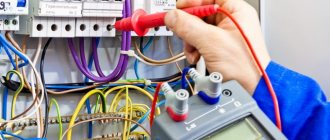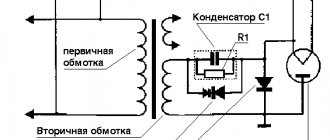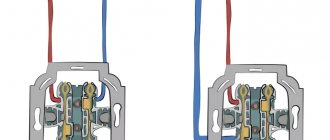Rules for handling electrical appliances
Safety rules when contacting electrical appliances must be observed everywhere. At home, on the street, at work, in production, there are different conditions for using electrical equipment. Consequently, the requirements for working with them will be somewhat different.
General actions
Home electrical appliances
Household appliances in the apartment are located in every room, with a particularly large number of them concentrated in the kitchen. The highest danger is when using equipment in combination with water, as the likelihood of electric shock increases.
To avoid serious consequences, you should follow safety precautions with household electrical appliances:
- Grounded outlets must be used to operate the equipment.
- Do not handle wires or operating equipment with wet hands.
- Do not pull the plug from the outlet by the cord.
- It is prohibited to use faulty devices.
- Do not disassemble or repair equipment that is plugged into an outlet.
- It is prohibited to simultaneously turn on a number of electrical appliances that exceeds the permissible number for a given consumer.
- It is dangerous to touch metal surfaces while holding a running electrical device.
Electrical safety at home
Note! Do not leave high-risk equipment unattended: irons, steam generators, air conditioners, heaters, electric stoves. Do not leave irons, hair straighteners, hair dryers on!
- Electric stoves should be installed at a distance of 50 cm from the curtains.
- In the kitchen, appliances must be placed at least 50 cm from the water tap.
- When turning on the equipment, there should be no knots or kinks on the cord to avoid insulation damage.
- Under no circumstances should you touch exposed wires or lighting fittings during installation.
- The cable should be connected first to the electrical appliance and then to the power source.
- You cannot dry things on electric heaters.
- Wires must be kept away from gas pipes, heating radiators, heaters, electric stoves, and other heating devices.
- Before connecting a new electrical appliance, you must carefully study the instructions.
Important! Do not screw in light bulbs with wet hands or while standing on a wet floor!
Only if the requirements are met will it be safe to work with equipment.
Outdoor electrical appliances
On the street, a person is surrounded by a huge network of wires and electrical installations. Rain, dew on the grass, puddles are an additional risk of electric shock. Accordingly, safety requirements increase when working with electrical appliances:
- It is prohibited to walk on wet ground, especially without shoes, while holding the device on.
- Do not tie clotheslines to drainpipes located near power lines.
- You cannot install, adjust, or repair antennas near wires.
- It is dangerous to touch any objects located on non-de-energized lines.
Danger of power lines
- It is prohibited to open transformer booths and other similar premises.
- Do not handle broken cables.
Note! For electrical safety on the street, one general rule can be drawn: it is prohibited to perform any actions near power lines or broken cables, especially during rain.
Handling electrical appliances in the office and at work
When hired, each employee undergoes safety training. All documentation on electrical safety is collected in the “Rules for labor protection during the operation of electrical installations”. After reading the instructions, the employee signs in the journal. This makes him responsible for improper handling of equipment and electrical appliances. In case of non-compliance with the regulations, the violator may be subject to administrative and even criminal liability.
In production, only specialists with appropriate education are allowed to work with electric current. And it is allowed to assign workers who have undergone training and certification to perform duties at electrical installations and receive a certificate. The procedure is also carried out by bosses and foremen who do not have direct contact with electricity, but are responsible for their subordinates.
Safety precautions at work and in the office require compliance with the following requirements:
- Work is permitted in special clothing.
- The equipment must be operated in good condition and strictly for its intended purpose.
- Placing power tools is permitted in premises of the appropriate protection class.
- When working in a damp environment, it is necessary to use a tool of a suitable protection class.
- Outsiders should not be allowed while working in laboratories, workshops, or other hazardous areas.
- Before starting the equipment, you should check the integrity of the wires and the serviceability of the sockets.
Equipment check
- Repair and replacement of spare parts is allowed only after de-energizing the devices.
- Do not twist or nail wires or cover them with any kind of floor covering.
- You cannot plug multiple electrical appliances into an outlet.
Correct equipment of the workplace and compliance with safety regulations are necessary factors for preserving the life and health of personnel.
Providing protection
Regardless of the nature of the planned event, during its implementation the requirements of the current sanitary rules and regulations officially adopted by the deputy must be complied with. chief physician and GOST. These standards define the maximum limits for magnetic field intensity:
- the electrical component must be in the frequency range 100 kHz-30 MHz - 20 V/m, 30-300 MHz - 5 V/m;
- the magnetic component must satisfy the operating range 100 kHz–1.5 MHz – 5 A/m.
To determine the intensity of the electromagnetic field, a special device IEMP-1 is used. The installation site for functioning generators must be a specially equipped room. Devices that are designed to heat dielectrics and metals can be installed in general production workshops. However, for their safe operation it is important to meet certain conditions .
- In workplaces, radiation should not exceed established limits.
- Personnel not involved in servicing such installations should be protected from exposure to radiation.
- For situations where it is necessary to perform heat treatment of dielectrics and metals, it is important to create exhaust ventilation.
- In order for air intakes to be reliably protected from heating by HF currents, they must be made of non-magnetic materials.
What to do if electrical appliances catch fire
Safety precautions when working with an iron
In everyday life, at work, or in nature, you may encounter an electrical appliance fire. The most important thing in any critical situation is to remain calm, because panic is a provocateur of mistakes.
Important! Do not put out a fire with water when an electrical appliance is plugged in!
In the event of a fire, it is necessary to de-energize the living space and unplug the wire from the power source. Only after this, cover with a thick, airtight fabric (blanket, bedspread, plaid). The lack of oxygen at the source of the fire will stop the process. The fire will not spread to other objects.
Extinguishing a fire device
If it is not possible to turn off the power to a device that has caught fire, the flame can be extinguished by covering it with dry soil from a flower pot, soda, and sand. This method will also block the air supply and stop the fire.
In case of electrical wiring fire, the technology is similar. You must first turn off the power to the room and then extinguish the fire. In offices and workplaces, safety precautions require the presence of a fire extinguisher.
It’s also nice to have such a device in the house. A carbon dioxide fire extinguisher is suitable for extinguishing a live appliance. But its use is harmful to human health.
Important! A carbon dioxide fire extinguisher may only be sprayed in ventilated areas.
For apartments and private houses, it is better to use a powder fire extinguishing agent. It can be used for fires under voltage up to 1000 V. In case of a power outage, foam or water fire extinguishers can be used.
Special cases
In accordance with safety precautions when repairing electrical equipment, it is allowed to begin any manipulations only after the voltage has been removed. Although there are exceptions to consider here. If there is a small amount of work to be done, then repair work can be carried out even in conditions of unrelieved tension. If you plan to repair devices with voltages up to 380 V, then a certain troubleshooting procedure must be followed. These works can only be carried out by specialists with a third group of electrical safety clearance. In addition to this, such work must be performed in the presence of another specialist who has a fourth or fifth group .
How to help the victim
Safety precautions when working with an angle grinder
The problem is that, having grabbed the source of danger with his hands, a person is not able to let go of the wire due to muscle spasm. Therefore, it is necessary to stop the impact of electricity on the victim:
- It is necessary to unplug the wire from the socket using non-conducting objects (wood, rubber, fabric) or cut it with pliers.
- If it is impossible to turn off the power to the device, you need to drag the victim away from it to a remote distance.
Methods for releasing a live element
Note! Do not touch the skin of a person under the influence of electric current with your bare hands!
After the measures have been completed, it is necessary to assess the person’s condition and begin providing first aid, taking into account the degree of electrical damage:
- While conscious, place it on a hard surface, treat the skin around the affected areas with iodine or potassium permanganate, and apply a dry bandage to the wounds.
- If he faints, free him from constricting clothing, try to bring him back to consciousness with ammonia and treat the burns.
- In a state of clinical death, resuscitate using chest compressions and artificial ventilation. If the muscles of the mouth are in spasm, then breathing should be done “mouth to nose.” The procedure should be performed before the ambulance arrives.
The consequences of an electrical injury can vary from mild dizziness to cardiac arrest. Timely first aid can save the victim’s life.
Electric Shock Hazard
Electric shock can cause shock and loss of consciousness, as well as apnea. When receiving an electric shock, a person suddenly falls unconscious, clenching their hands tightly. Most often, the clenched hand contains an electrical wire. There may be deep burn wounds where the body comes into contact with the current. The degree of damage depends on the magnitude of the voltage and current, its duration and the path of flow.
Danger from electrical appliances
Important! Electric shock causes extensive and deep burns. Voltages between 500 and 1000 volts cause internal burns.
Another consequence of electric shock is ventricular fibrillation, which can even cause a short-term current of 110-230 volts to pass through the chest. This process can be fatal because in ventricular fibrillation, all myocardial cells move independently rather than in the coordinated manner necessary to pump blood and maintain circulation. At very high tensions, muscle contractions are so strong that the heart muscles can no longer move.
In addition, electricity leads to serious neurological disorders. It disrupts nervous control of the heart and lungs, which leads to disruption of the central nervous system, breathing and circulation. When current flows through the brain, the person almost always loses consciousness.
Very high voltage electricity and repeated shocks can cause neuropathy.
Electric shock is extremely dangerous to human health and life. Death can result from cardiac arrest due to ventricular fibrillation, although the most common cause of death in people with electrical shocks is extensive and deep burns. If the voltage is very high, charring of the body occurs.
Below is a table of current threshold values.
| Voltage | Sensible (mA) | Non-releasing (mA) | Fibrillation (mA) |
| Variable (50Hz) | 1,0-1.5 | 12,0-15,0 | 100,0 |
| Permanent | 6,0 | 60,0 | 300,0 |
Operational maintenance of electrical equipment
Within the framework of this activity, the following main activities can be distinguished:
- Monitoring the operating mode and status of devices;
- Providing information about the operation of equipment.
If, as a result of a routine inspection malfunctions of the devices , then the personnel must react promptly and do everything necessary to troubleshoot the problem. In order to reduce the number of equipment failures, it is important to carry out preventive and repair work on a regular basis.
An important point is to ensure safe conditions for carrying out any event in relation to functioning devices. These requirements are enshrined in the PTB, adopted by decision of the Department of the Ministry of Electrification and Energy.
Personnel protection
There are a number of measures that can be used to solve this problem:
- Control of radiation intensity by a magnetic field source, not allowing it to exceed the permissible level.
- Use of personal protective equipment, as well as installation of automatic warning alarms.
- The installation of a protective screen, an alternative to which can be the location of workplaces at a safe distance from radiation sources, as well as the use of remote control.
- Selecting the optimal mode for equipment, which will ensure the efficiency of its operation and the safety of employees.
Shielding method
In the case of induction heating installations, general shielding is usually used. An important requirement here is the placement of a hardening inductor and a control panel behind the screen . Another option you can do instead is create a block-by-block screen for each zone. With this option, the capacitor element must provide an appropriate form of execution, which must be made in the form of a metal mesh or chamber. When creating a transformer screen, it is important that it has a steel casing.
When manufacturing an element of a melting or heating inductor, it is given the appearance of a metal movable chamber. The process of operating the equipment will be accompanied by movement of the chamber: when the temperature rises, it will lower; when normal temperature conditions are restored, the chamber will take its original position. When creating a screen, it can be given the appearance of a fixed camera equipped with a door. The latter will provide free access in a situation where you need to replace the heating element.
Do not touch exposed wires!
Let's talk about one more rule. Electric current moves through the wires, so they should be protected first. Each of them that is connected to the network must have an insulating coating resembling a plastic, fabric or rubber tube - an insulator. It is impossible to get an electric shock through it. But there are times when the wire sheath is damaged. When exposed, it should never be picked up by hand. Parents and teachers are required to announce the rules for using electrical appliances for children, so that when walking on the street after school and seeing a bare wire, the child will immediately inform an adult about it.











